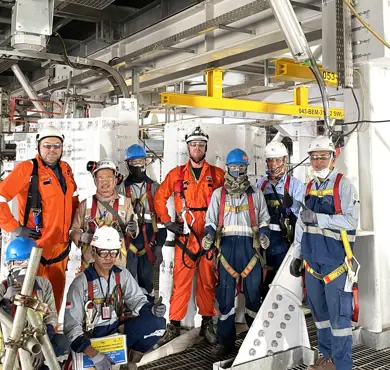At BP's LNG facility in Indonesia's Papua Barat province, Beerenberg is now installing fire protection at 150 structural junctions. As the facility is located in an earthquake zone, the fire protection must withstand earthquakes. Traditional wet-applied fire insulation will not be able to be used at the junctions, as it will crack when minor tremors occur since the beams must be able to move during an earthquake.
The solution is Benarx® structure panels which allow the beams to move 20 – 30 mm both vertically and horizontally during an earthquake. At this facility, the structure has a fire requirement of 2.5 hours, so it is a relatively tough requirement to be met.
BP is the operator of Tangguh LNG, where the facility is now being expanded with a third production train. Our customer on the project is a consortium where Saipem from Italy and Chiyoda from Japan are the leading players.
- After surveying the facility this summer and producing the panels in Thailand earlier this autumn, we now have personnel present to lead the installation which will continue until Christmas. This is a good example of cooperation between the different companies in Beerenberg. Design engineering is carried out by our team in Poland, documentation is provided by the engineering department in Bergen, while the project is managed by Gary Kolderup and his team in Singapore, says Per Lange, VP Asia Pacific.
The installation is being carried out by local workers under the direction of three employees from Beerenberg and should be completed before Christmas.
So far, we have only received good feedback from the customer on the product and the way we carry out the project.
Highly flammable
Liquefied natural gas (LNG) mainly consists of methane (85-99%) and some ethane, and is classified as "highly flammable". Should there be a leak of LNG into the environment, it will begin to evaporate and turn into gas that can catch fire if the amount of gas in the air is between 5 and 15 percent by volume. This means that natural gas can only burn when a certain mixture of gas and oxygen occurs. Methane is not toxic, but can displace oxygen and is highly flammable. Liquefied gas is very cold and also presents a risk of severe frostbite.
Earthquake area
Indonesia has been hit by more than 150 major earthquakes with a magnitude above 7 in the last hundred years. The reason for the frequent earthquakes is that the tectonic plates in the earth's crust collide in this area. The most powerful earthquake was in 2004, with a magnitude of 9.1, in the sea off Sumatra in the north of the country. The earthquake triggered a tsunami that hit 14 countries. 226,000 people around the Indian Ocean lost their lives, and more than half of the victims were in Indonesia.
About the facility
BP's LNG facility is located in Papua Barat province in Indonesia and consists of six large gas fields. The gas reserves were discovered in the mid-1990s by Atlantic Richfield Co. (ARCO) and Tangguh LNG are operated by BP Berau Ltd. (100% owned by BP). Other wholly owned BP subsidiaries at Tangguh LNG development are BP Muturi Holdings B.V., BP Wiriagar Ltd. and Wiriagar Overseas Ltd. - which gives BP a 40.22% consolidated stake in Tangguh LNG.
BP's LNG facility is located in Papua Barat province in Indonesia and consists of six large gas fields.


